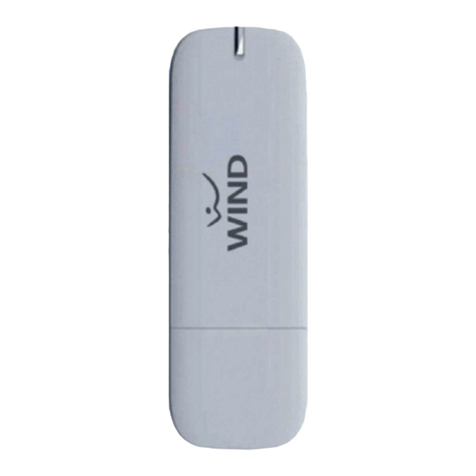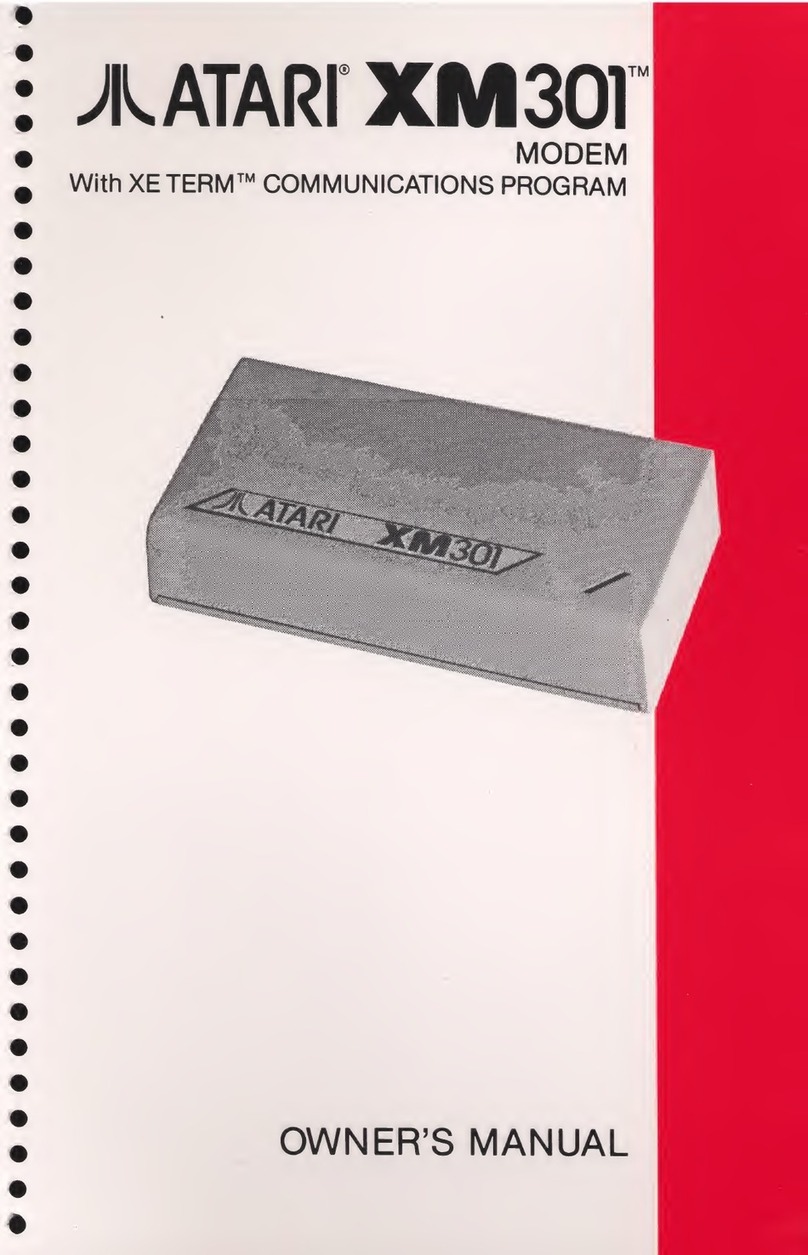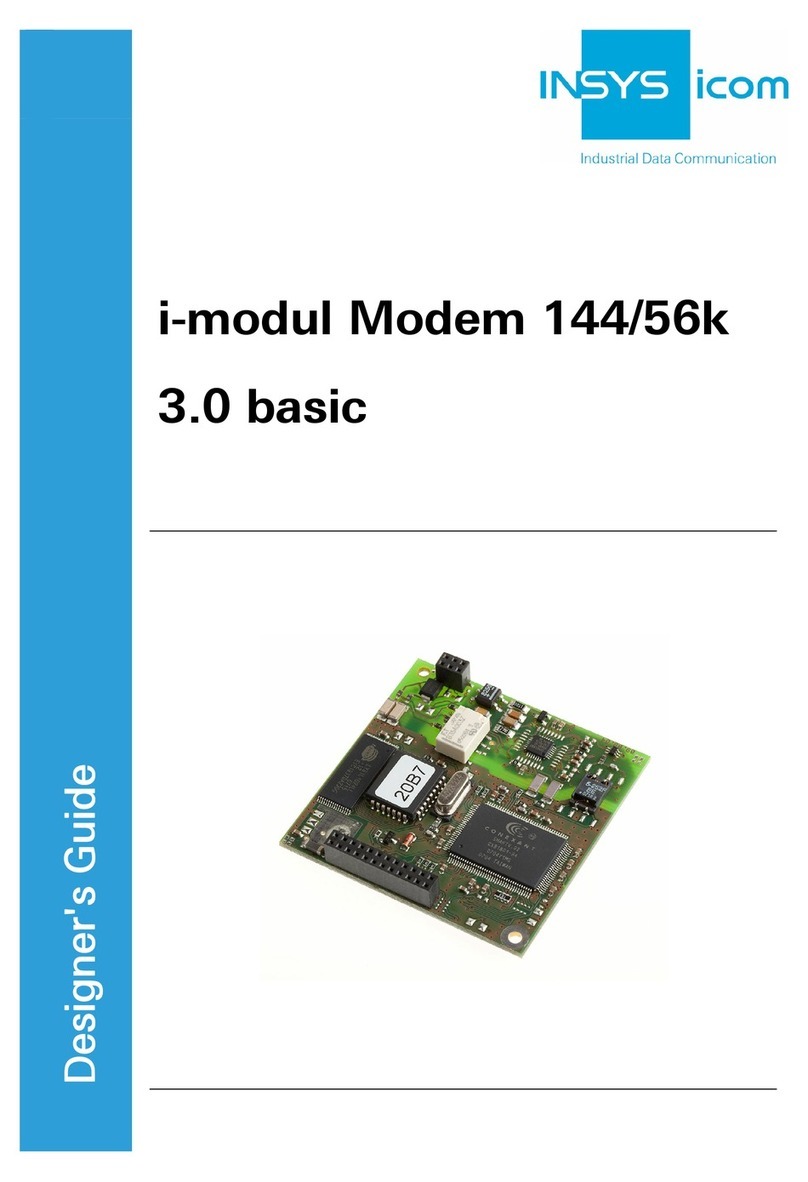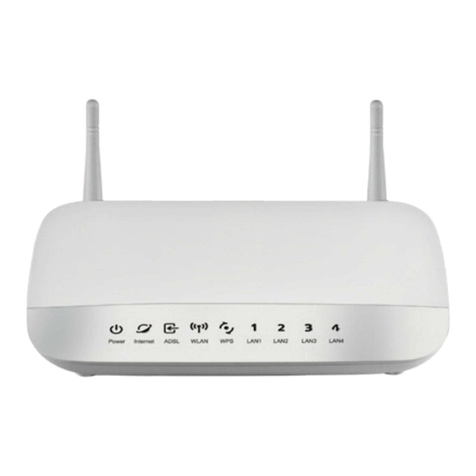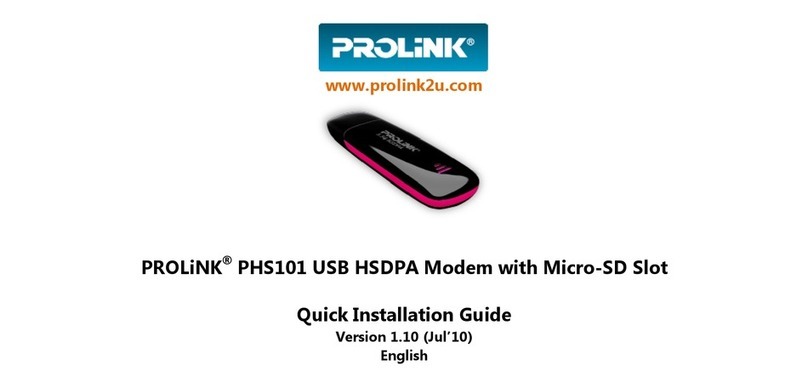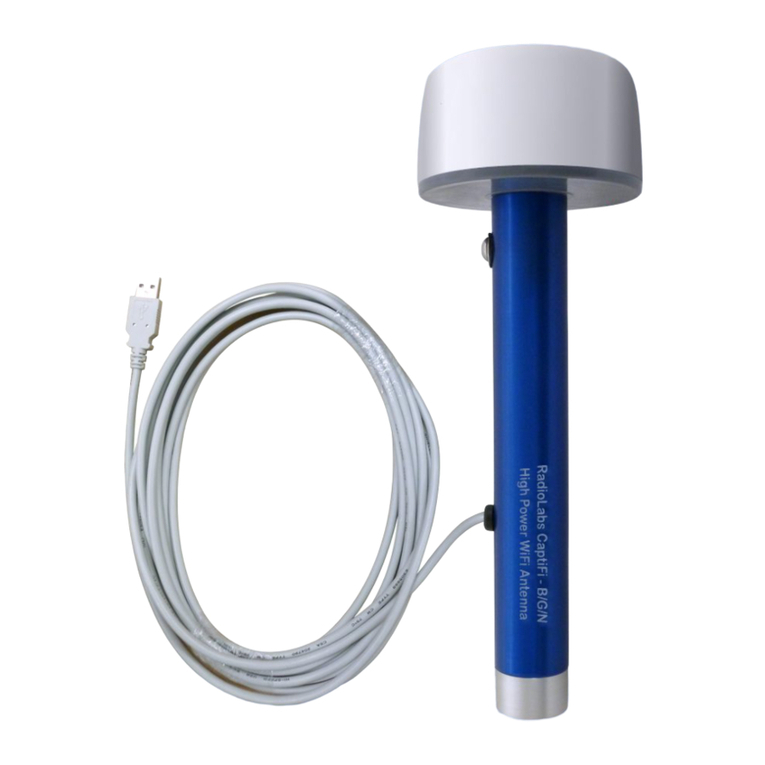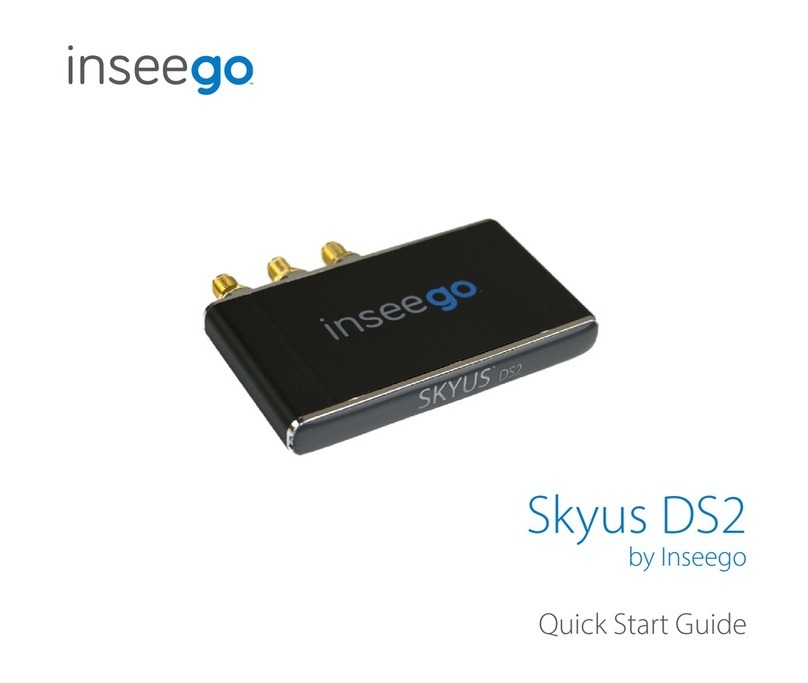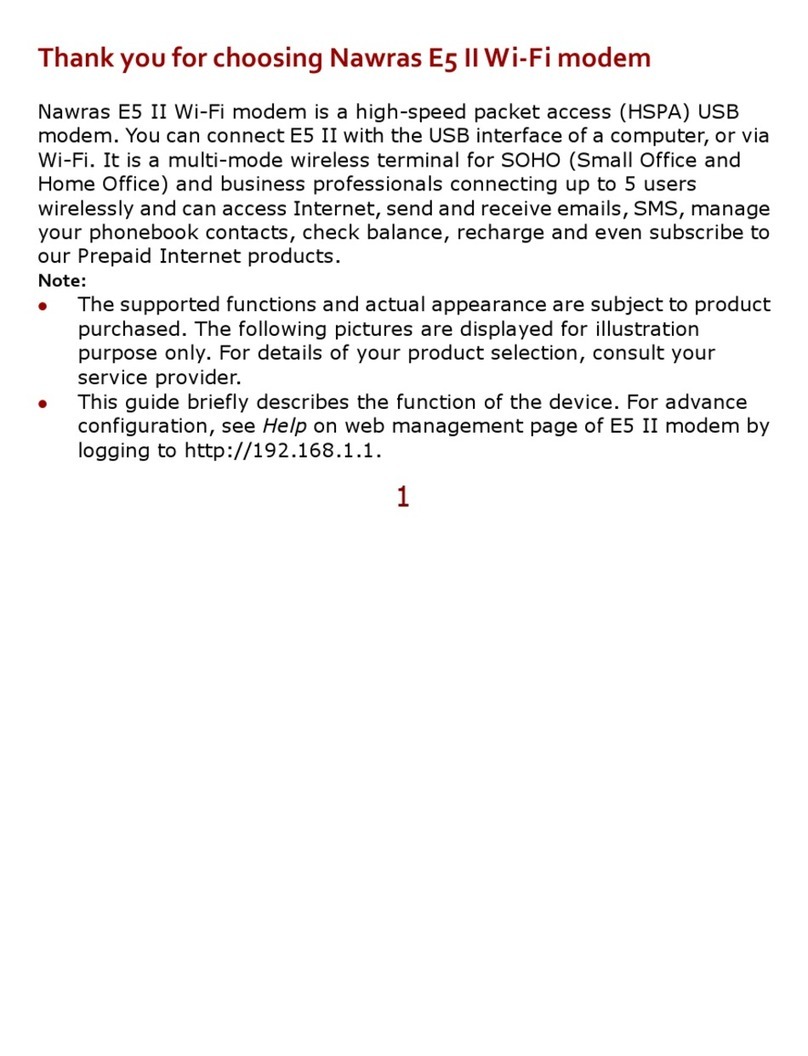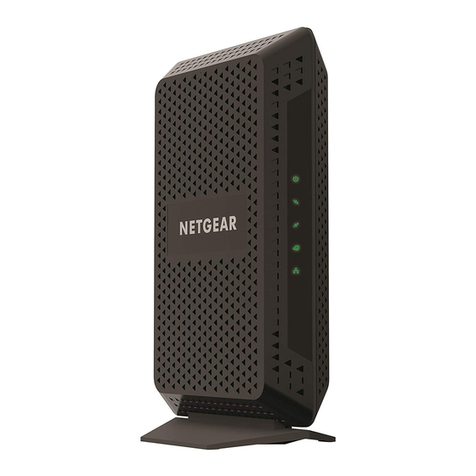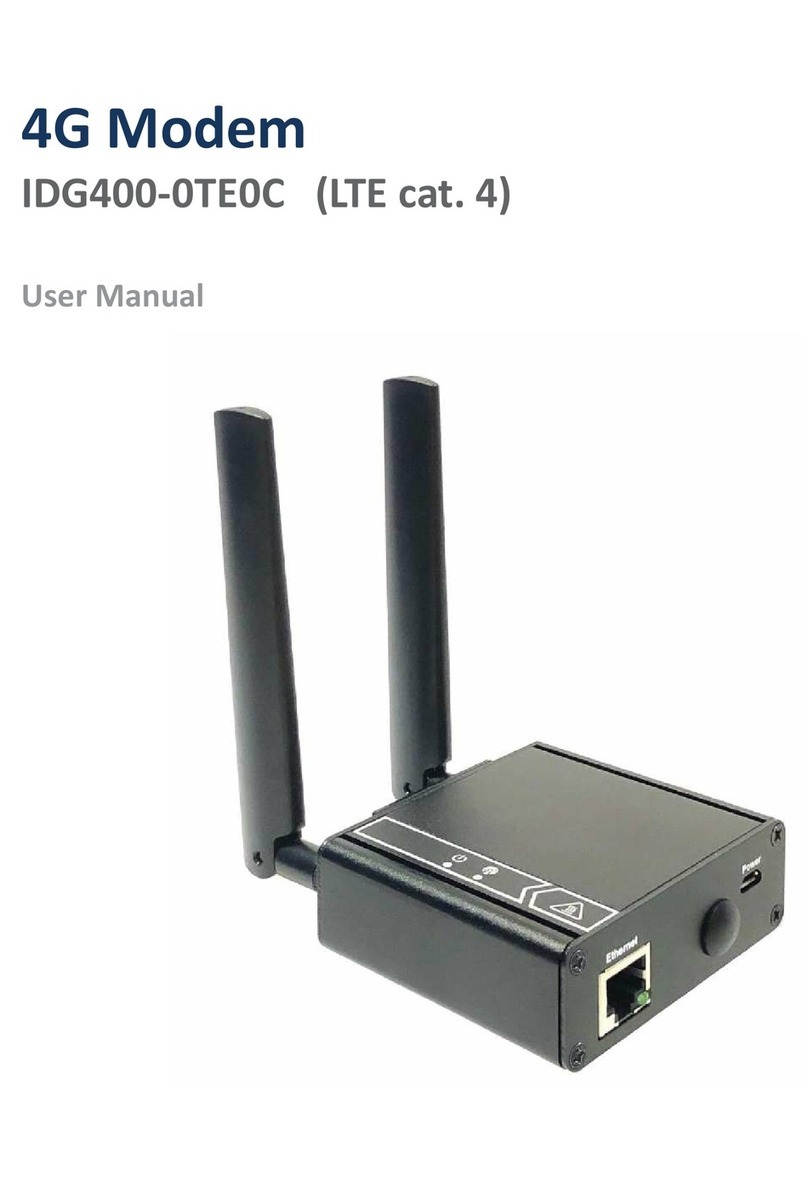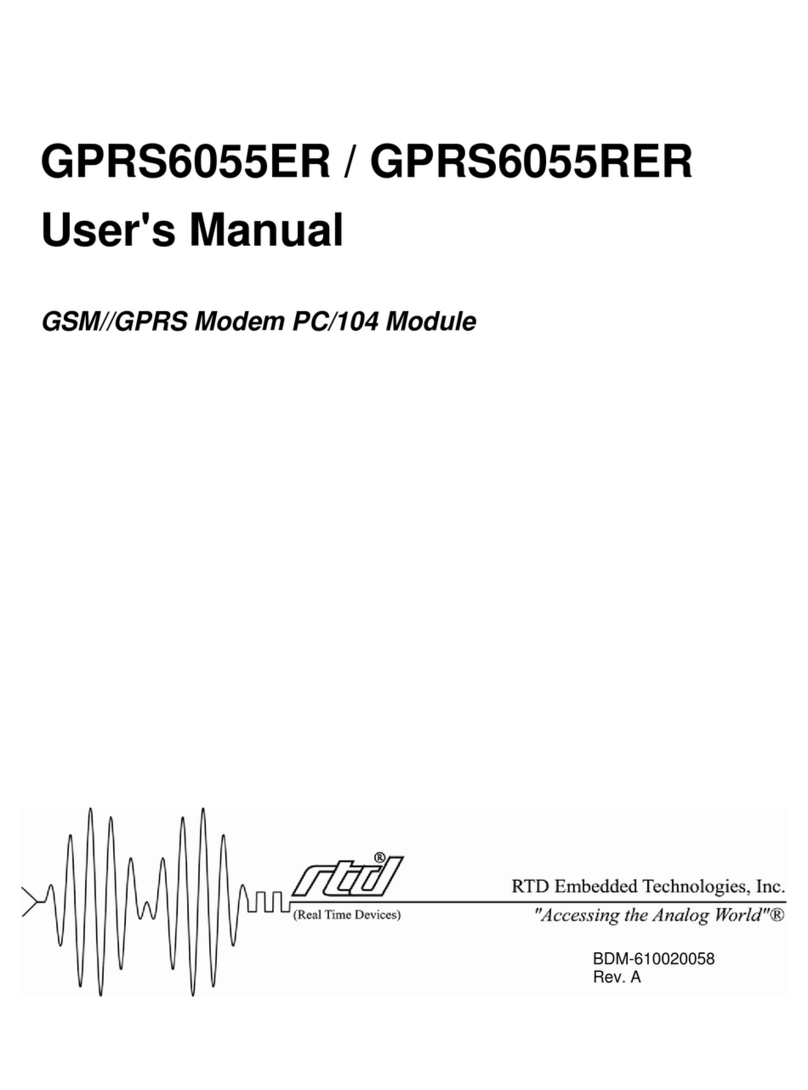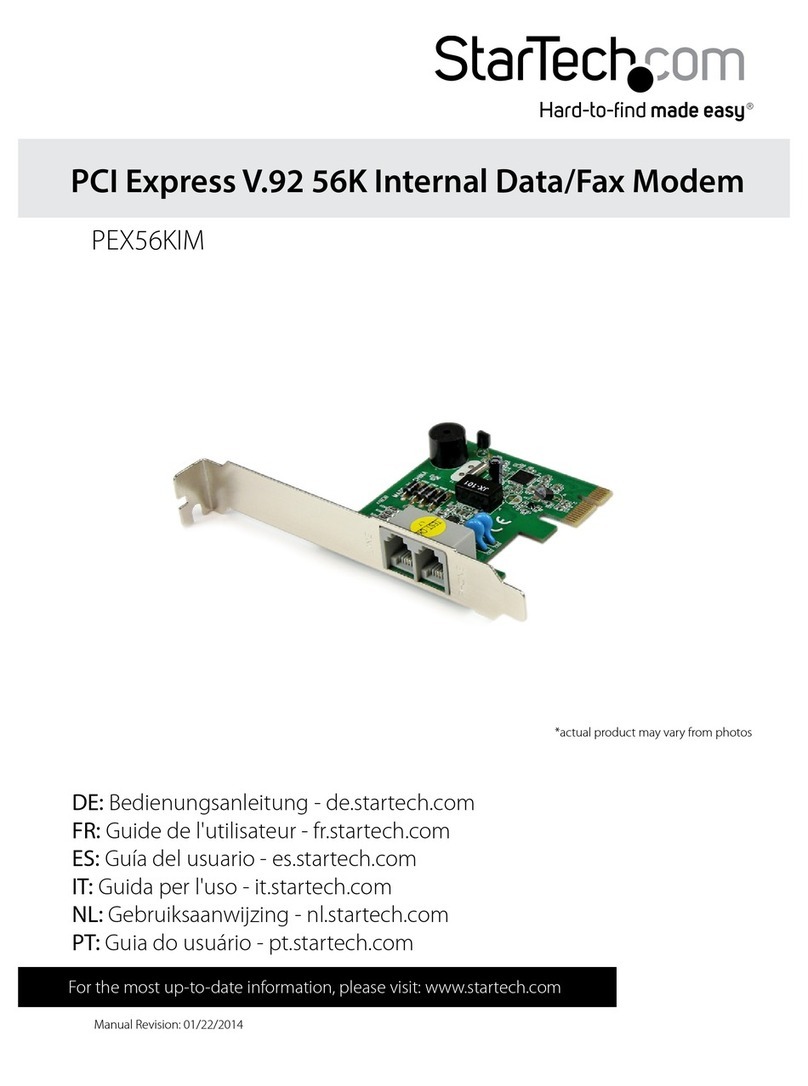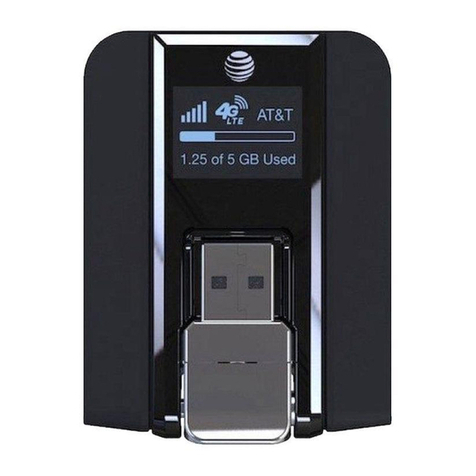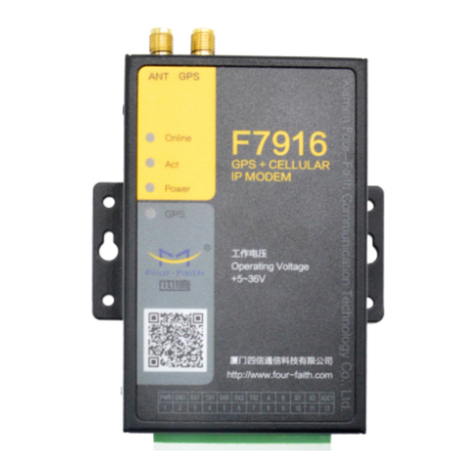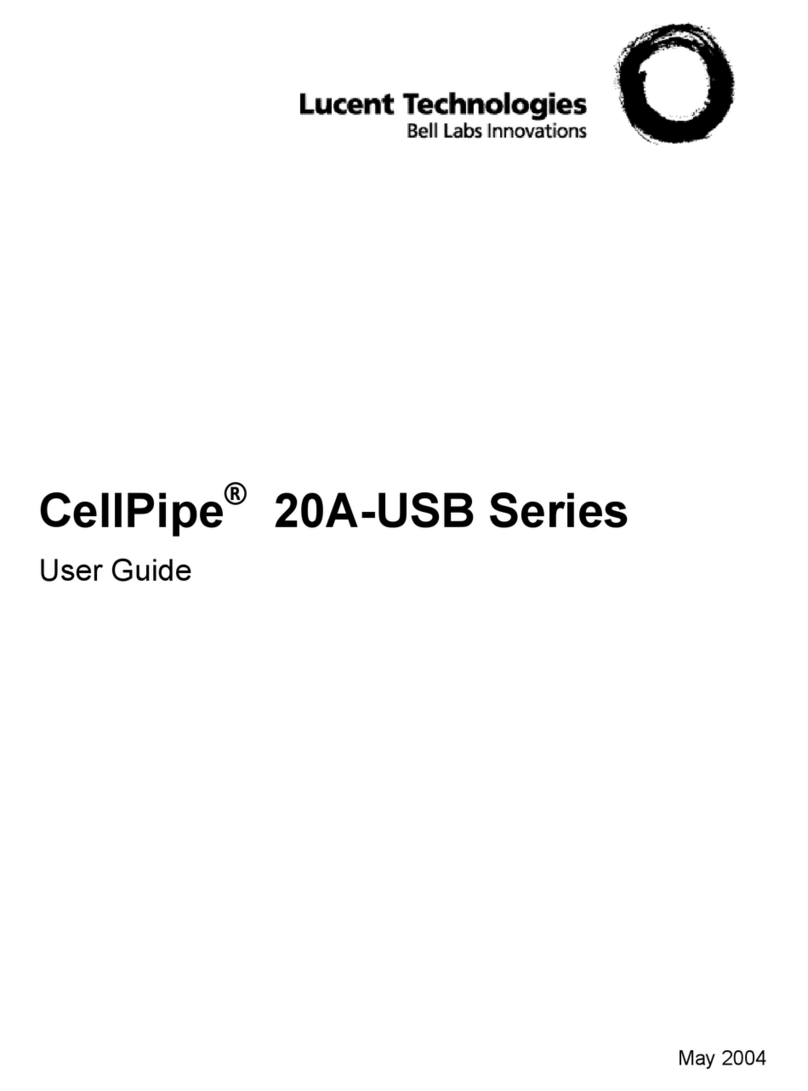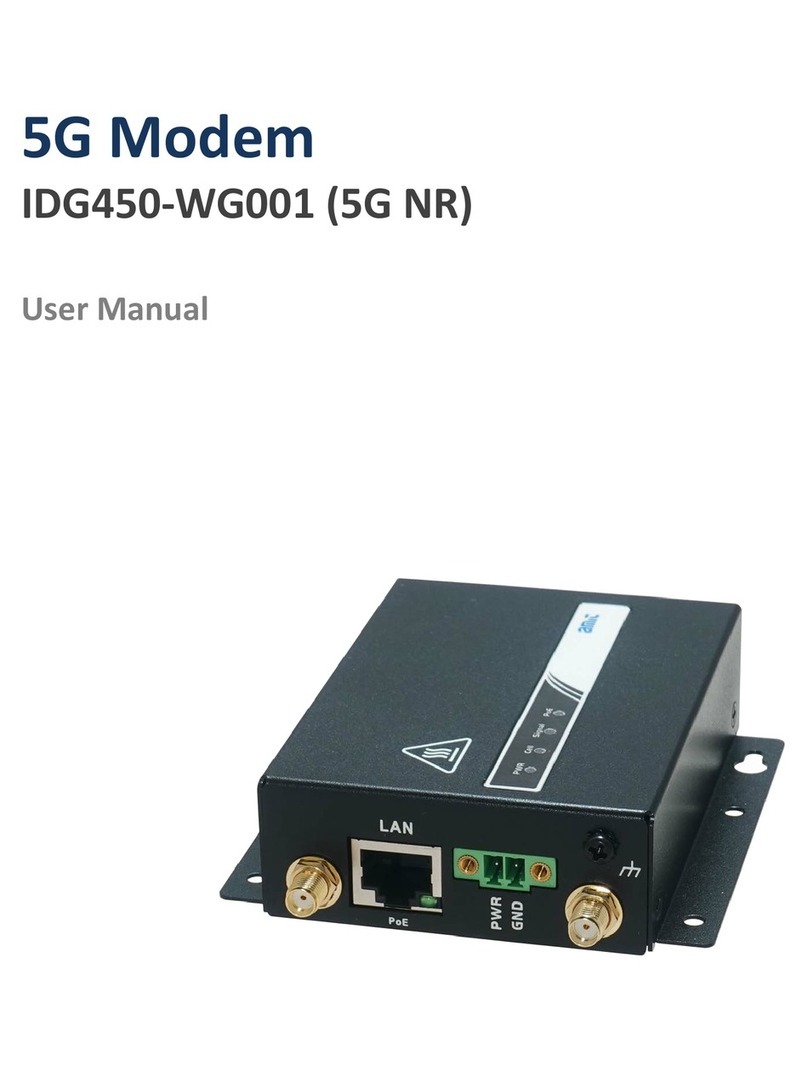Bausch Datacom DinBox PSTN User manual

Reference manual
DinBox PSTN (485)
modem

DinBox PSTN Reference manual –V1.3
Bausch Datacom NV
2
! CAUTION !
ELECTRIC SHOCK HAZARD IF COVER REMOVED
SERVICE BY QUALIFIED PERSONEL ONLY
Document History
Date Version
Status Author Info
21/10/2004 V1.0 Preliminary Filip Lavaerts Creation
22/02/2005 V1.1 Filip Lavaerts DinBox PSTN(485) ?RS-485 option
18/03/2005 V1.2 Filip Lavaerts Selective CID answer function (8.2.4)
PSTN line connection (4.3)
08/02/2006 V1.3 Filip Lavaerts Approval info
Jumper JP2 / RS-485 example / RS-232 connections

DinBox PSTN Reference manual –V1.3
Bausch Datacom NV
3

DinBox PSTN Reference manual –V1.3
Bausch Datacom NV
4
Serial signal flow definition in this manual
DCE
DTE
TxD
RxD
DTR
DCD
RTS
CTS
RI
DSR
GND
Modem
DinBox PSTN
...
Communication
device
PC
POS
PLC
...
Application
IN
OUT
Data
Terminal
Equipment
Data
Communication
Equipment

DinBox PSTN Reference manual –V1.3
Bausch Datacom NV
5
1. Introduction 6
2. Block Diagram 7
3. Specifications 8
3.1 Housing 8
3.2 Connectors 9
3.3 Environmental conditions 9
3.4 Power Supply specifications 9
3.5 PSTN modem specifications 10
4. Ports and Connectors 11
4.1 Power connection 11
4.2 Standard DTE Interface 12
4.3 PSTN connection 12
5. LED Indicators 13
6. Watchdog functionality 13
7. RS-485 interface 14
7.1 External connections 14
7.2 Schematic overview of the RS-485 circuit 15
7.3 Possible jumper settings 16
7.4 Example configuration for RS-485 communication 17
8. AT-commands interface 18
8.1 Standard command overview 18
8.2 Enhanced features 22
8.2.1 Dump mode 22
8.2.2 Leased line configuration 22
8.2.3 Asynchronous DTR-dailling 23
8.2.4 Selective CID answer 23
A. Certificate of compliance c-CSA-us 24
B. EC-declaration of conformity 26

DinBox PSTN Reference manual –V1.3
Bausch Datacom NV
6
1. Introduction
This manual is the reference book when setting up theDinBox PSTN(485) modem for
your application. Because of the nature of this product and it's field of application, some
degree of technical background knowledge regarding the application and data-
communication is assumed.
The DinBox PSTN(485) modem is a versatile communications device designed to
provide a very flexible data communication solution for an industrial environment.
To ensure problem free communication, theDinBox PSTN(485) is equipped with a ‘long
term’-watchdog. This circuit will ‘hard’ reset the modem every 24 hour.
The DinBox PSTN(485) is designed to transmit and receive data on the Public
Switched Telephone Network -PSTN.
The DinBox PSTN(485) has a lot of enhanced communication features implemented :
-error correction / data compression
-Caller ID detect
-V.22bis fast connect
-2-wire analogue leased line
-dump mode
-asynchronous DTR dialing
The DinBox PSTN(485) is designed in a robust 22.5 mm wide DIN rail housing with a
wide range DC-power supply.
The DinBox PSTN(485) version has an internal RS-485 2-wire and 4-wire interface.
See chapter 7 for more details about this interface.

DinBox PSTN Reference manual –V1.3
Bausch Datacom NV
7
2. Block Diagram
The block diagram below details the location and interconnection of the different
functional units within the modem. The most important units are briefly described.
Power Supply
The power supply (DC) must be connected to theDinBox PSTN(485) modem via a
terminal block with screw contacts. Make sure the voltage supplied to the modem is in
the range of theDinBox PSTN(485) input voltage (see specifications for details on
voltage range).
This input is protected against reversed polarity with a serial diode.
DTE Interface
The DinBox PSTN(485) modem has a RS-232 interface (RJ-45) witch can be
connected to a computer or similar device via included RJ-45/DB-9 serial cable.
The DinBox PSTN(485) has a buid-in 2-wire and 4-wire RS-485 interface.
PSTN Modem
The DinBox PSTN(485) modem has a Conexant modem chip. Connection with the
PSTN network is done via a standard RJ-11 connector.
Watchdog circuit
A long-term watchdog circuit is implemented. The power supply of the PSTN modem will
be disconnected for a few seconds after the selected reset period.
If a part of theDinBox PSTN(485) is ‘locked’ after e.g. an unexpected high ESD
discharge, surge pulse or an internal lock-up, this watchdog will always insure the
continuity of communication.
RS-232
RS-485
10
-
40 Vdc
PSTN
TxD RxD DCD
DTE
Interface
Power
Supply
Watch
DOG
PSTN
Modem

DinBox PSTN Reference manual –V1.3
Bausch Datacom NV
8
3. Specifications
3.1 Housing
Phoenix Contact EG22,5 ABS DIN rail housing
(EG22.5-G/ABS GN + EG22.5-A/ABS GN)
?? 22.5 mm 107.5 mm x 75 mm
?? IP40
?? Symmetrical DIN rail mounting according EN50 022
?? Green color
Standard ABS
Acryl Butadiene Styrene – Tmax = 80 °C
Inflammability class acc. to UL 94 : HB
Optional PC (only on special request)
Polycarbonate –Tmax = 115 °C
metal DIN-rail clip
Inflammability class acc. to UL 94 : V0

DinBox PSTN Reference manual –V1.3
Bausch Datacom NV
9
3.2 Connectors
Power Supply 4-pin header (MSTBO2.5/4-GR(L)-5.08)
pitch : 5.08 mm / Inom : 12 A / Unom : 250 V
& Not Used 4-pin plug (MVSTBW2.5/4-ST-5.08)
pitch : 5.08 mm / Inom : 12 A / Unom : 250 V / Max. conductor cross section, flexible : 2.5 mm²
RS-485 4-pin header (MSTBO2.5/4-GR(L)-5.08)
pitch : 5.08 mm / Inom : 12 A / Unom : 250 V
Connections 4-pin plug (MVSTBW2.5/4-ST-5.08)
pitch : 5.08 mm / Inom : 12 A / Unom : 250 V / Max. conductor cross section, flexible : 2.5 mm²
PSTN line RJ-11
Serial DTE RJ-45 8x8 (Molex)
3.3 Environmental conditions
Temperature in use -10°C / + 50°C
Humidity in use 10% -75% (non condensing)
3.4 Power Supply Specifications
Input voltage range: 10 –40 Vdc regulated
Typical power consumption : 150mA (Max., Operating on-line)
CTS
RTS
RI
GND
DTR
TXD
RXD
DCD
-
+
Power
Supply
x x
Not
Used
RS
-
485
4 3 2 1
Line
RJ-11
Serial DTE
RJ-45
DCD
WD
RxD
TxD
A’
A
B
B’

DinBox PSTN Reference manual –V1.3
Bausch Datacom NV
10
3.5 PSTN modem Specifications
?? ITU-T V.92 with PCM upstream rates up to 48 kbps, QuickConnect and Modem-on-hold functions
?? V.92, V.90, V.34, V.32bis, V.32, V.22 bis, V.22, V.23, and V.21; Bell 212A and Bell 103
?? V.22 bis fast connect
?? V.250 and V.251 commands
?? V.253 commands
?? Data compression and error correction
?? V.44 data compression for optimal downloading of Internet Web pages and files
?? V.42 bis and MNP 5 data compression
?? V.42 LAPM and MNP 2-4 error correction
?? MNP 10EC(tm) enhanced cellular performance
?? Flow control and speed buffering.
?? Automatic format/speed sensing.
?? RS-232 Serial async interface, supports speeds up to 230.4 Kbps
?? 11-bit Direct mode
?? Fax modem
?? V.17, V.29, V.27 ter, and V.21 channel 2
?? EIA/TIA 578 Class 1 and T.31 Class 1.0 commands
?? Upgradeable Flash ROM
?? Data/Fax/Voice call discrimination
?? Hardware-based modem controller and digital signal processor (DSP)
?? Worldwide operation
?? Call progress, blacklisting
?? Distinctive ring detect
?? Caller ID detect
?? Off-hook Call Waiting Caller ID detection during data mode in V.92, V.90, V.34, V.32bis, or V.32
?? 2-bit and 4-bit Conexant ADPCM, 8-bit linear PCM, and 4-bit IMA coding 8 kHz sample rate
?? Concurrent DTMF, ring, and Caller ID detection
?? 2-wire Leased Line
?? Dump mode
?? Asynchrone DTR-dialling

DinBox PSTN Reference manual –V1.3
Bausch Datacom NV
11
4. Ports and Connectors
Before you start the installation, take a moment to become more familiar with the
possible connections to and from theDinBox PSTN(485) modem.
Disconnect the mains power before connecting or
disconnecting the power and/or DTE plugs !
4.1 Power Connection
PIN
++ DC
--DC
Always disconnect the mains power before connecting or disconnecting the power.
Make sure the voltage supplied to the modem is in the range of theDinBox PSTN(485)
power supply specification (see specifications for details on voltage range).
-
+
Power
Supply
x x
Not
Used
RS
-
485
4 3 2 1
Line
RJ-11
Serial DTE
RJ-45
DCD
WD
RxD
TxD

DinBox PSTN Reference manual –V1.3
Bausch Datacom NV
12
4.2 Standard DTE Interface
Only devices which are conform with the safety
regulations can be connected to the DTE port!
The DinBox PSTN(485) is equipped with a RJ-45 (8x8) connector. This is the serial
interface of the modem.
A Bausch RJ-45 to a standard DB9 (female) cable is delivered with theDinBox
PSTN(485) modem.
EIA/TIA561 pin layout is possible on special request (info in RED).
Pin
RJ45 Pin
RJ45 Pin
DB9 V.24/V.28 I/O TEXT
Bausch EIA/TIA
561 CCITT DIN EIA
121109 M5 DCD OData carrier detect
252104 D2 R D OReceive data
363103 D1 T D ITransmit data
434108/1
108/2
S1.1
S1.2
DTR IData terminal ready
545102 E2 GND --- Signal ground
--6107 M1 DSR OData set ready
787105 S2 RTS IRequest to send
878106 M2 CTS OClear to send
6-9125 M3 RI ORing indicator
Output: from DCE (modem) to DTE (terminal)
Input: from DTE (terminal) to DCE (modem)
8 CTS
7 RTS
6 RI
5 GND
4 DTR
3 TXD
2 RXD
1 DCD
8 RTS
7 CTS
6 TXD
5 RXD
4 GND
3 DTR
2 DCD
1 -

DinBox PSTN Reference manual –V1.3
Bausch Datacom NV
13
The DinBox PSTN(485) modem will detect the DTE port speed (auto baud), number of
data bits and parity type from the "AT" header that precedes every command (in async
mode).
The &W command automatically saves the baud rate, number of data bits, parity and
number of stop bits.
4.3 PSTN connection
The DinBox PSTN(485) modem has to be connected to a PSTN line via the RJ-11
connector.
There are 4 pins connected :
A / B ?connection to the telephone network
A’ / B’ ?connection for a parallel connected telephone
A is always connected to A’ and B is always connected to B’. Therefore it is sometimes
necessary to use a 2-wire telephone cable (only 2 wires in the middle) when theDinBox
PSTN(485) is connected to a digital PABX with analogue telephone lines. A’ and/or B’
can be used as signalling lines between the telephone and the PABX.
5. LED indicators
TxD Transmit Data from DTE to modem
RxD Receive Data from modem to DTE
DCD Data Carrier Detect from modem to DCE
WD Watchdog heartbeat 1 sec on/off
6. Watchdog functionality
To prevent a “total lock-up” of theDinBox PSTN(485) a long term watchdog is
implemented. This function is created with a separate RISC micro controller. The micro
controller itself is guarded with it’s own internal watchdog (+/-1 second refresh/ WD
LED flash).
The power supply to the communication control processor and the modem module will
be disconnected for a few seconds after +/-24 hour IF the modem is NOT connected
(inactive DCD signal).
If the reset period is endedand the modem is connected to a remote host (active DCD
signal) the reset will not be conducted.
If the reset period is endedand the watchdog already past a reset, because of an active
DCD signal, the reset will be conducted after +/-10 minutes !
Otherwise, if theDinBox PSTN(485) is “locked-up” with an active DCD signal the
watchdog will never be able to reset the WAN module.
A’
A
B
B’

DinBox PSTN Reference manual –V1.3
Bausch Datacom NV
14
7. RS-485 interface
The DinBox PSTN(485) has an internal RS-485 4-wire and 2-wire interface. See the
next chapters for more information about the use and setup of this interface.
7.1 External connections
The RS-485 interface must be connected via the screw contacts on the opposite side of
the power connection.
2-wire 2-wire signal flow
4-wire 4-wire signal flow
1--RCV/z output –to DTE
2Bin/out XMIT/b input –from DTE
3Ain/out XMIT/a input –from DTE
4 --RCV/y output –to DTE
See page 4 for theserial V.24 signal flow definitions in this manual. A modem is a DCE
device, receive is output and transmit is input !
In chapter 7.2 you will find a schematic overview of the RS-485 circuit.
In chapter 7.3 you will find an overview of the possible jumper settings.
-
+
Power
Supply
x x
Not
Used
RS
-
485
4 3 2 1
Line
RJ-11
Serial DTE
RJ-45
RXD
TXD
DCD
WD

DinBox PSTN Reference manual –V1.3
Bausch Datacom NV
15
7.2 Schematic overview of the RS-485 circuit
/RXD
B
A
receiver
transmitter
47 E
47 E
IO 4
IO 1
560 E
120 E
JP10
JP11
JP9
9V1
4V7
560 E
B
A
47 E
47 E
dT
receiver
transmitter
~recEN
traEN
IO 3
IO 2
560 E
120 E
JP2
JP4
JP8
JP3
9V1
4V7
560 E
/RXD
Y
Z
/TXD
JP6
JP5
JP7
1
3
1
1
3
3

DinBox PSTN Reference manual –V1.3
Bausch Datacom NV
16
7.3 Possible jumper settings
11 jumpers are to be set for a correct RS-232 / RS-485 interface configuration.
Function 1-22-3Open Close
JP1 How to switch between the
RS-232 and RS-485
interface ?
DTR active
RS-232
DTR not active
RS-485
Always
RS-232
See note(1)
--
JP2 Delay after sending a
character (DCE > DTE)
and enabling the receiver
again (DTE > DCE, idle
state)
--+/-20 ms
1200 bps
2400 bps
4800 bps
+/-2 ms
>= 9600 bps
See note(2)
JP3 Termination ?line 2-3--No resistor 120 E
JP4 + onto line 3 ---+ connected
JP5 B line switch 2-wire 4-wire --
JP6 A line switch 2-wire 4-wire --
JP7 /TXD switch 2-wire 4-wire --
JP8 -onto line 2 ----connected
JP9 Termination ?line 1-4--No resistor 120 E
JP10 + onto line 4 ---+ connected
JP11 -onto line 1 ----connected
(1) The DTR signal is not active when the DTE–DCE connection is done by using a 3-
wire RS-232 interface (RXD, TXD and GND). Use JP1 position 2-3 to lock the RS-232
interface. By default JP1 position 1-2 is used : when the DTR is active, f.e. during
configuration of theDinBox PSTN(485), the RS-232 interface is active. If no DTR, the
RS-485 interface is active.
(2) It is preferred to disable autosensing and lock the interface speed with the +IPR
command when the baudrate is higher or equal then 9600 bps.
1 JP1 3
3 JP7 1
3 JP6 1
3 JP5 1
JP2
JP3
JP9
JP11
JP8
JP4
JP10

DinBox PSTN Reference manual –V1.3
Bausch Datacom NV
17
7.4 Example configuration for RS-485 communication
The RS-485 interface must be connected via the screw contacts on the opposite side of
the power connection.
Connect a terminal (PC) to the RS-232 interface (RJ45). TheDinBox PSTN(485) will
automatically switch to the RS-232 interface if DTR is present (JP1 on 1-2 position).
Verify the correct communication parameters, for example 9600 8N1.
Send the commands below to theDinBox PSTN(485) modem.
at&f ‘ factory reset
at+ipr=9600 ‘ autosensing off, lock on 9600 bps
at&d0 ‘ no DTR
at&k0 ‘ no RTS / no flow control
atk0 ‘ dump mode
ats0=0 or x ‘ no answer (0) or answer after x rings
ate0 ‘ local echo off
at&w ‘ save in NVRAM
It’s important to disable local echo (ate0) when RS-485 2-wire is used !

DinBox PSTN Reference manual –V1.3
Bausch Datacom NV
18
8.AT Command interface
8.1 Standard command overview
The configuration of theDinBox PSTN(485) is done by sending AT command to the
modem, changing S-registers into the modem and interpreting the responses sent by
the modem.
We have added the original Conexant reference manual onto the CD-ROM.
Below you will find a overview of all the possible command and S-registers.
Data Commands 3-2
Generic Modem Control 3-2
Z -Soft Reset and Restore Profile 3-2
+FCLASS -Select Active Service Class 3-2
+VCID -Caller ID (CID) 3-3
+VRID -Report Retrieved Caller ID (CID) 3-4
\N -Operating Mode 3-5
I -Identification 3-6
+GMI -Request Manufacturer Identification 3-7
+GMI9 -Request Conexant Identification 3-7
+GMM -Request Model Identification 3-8
+GMR -Request Revision Identification 3-8
+GCAP -Request Complete Capabilities List 3-8
+GCI -Country of Installation 3-9
&F -Restore Factory Configuration (Profile) 3-10
&T -Local Analog Loopback Test 3-10
&Y -Designate a Default Reset Profile 3-11
&W -Store Current Configuration 3-11
&Zn=x -Store Telephone Number 3-12
%7 -Plug and Play Serial Number 3-12
%8 -Plug and Play Vendor ID and Product Number 3-13
**-Load Flash Memory 3-14
DTE-Modem Interface commands 3-17
E -Command Echo 3-17
Q -Quiet Results Codes Control 3-17
V -Result Code Form 3-18
W -Connect Message Control 3-18
X -Extended Result Codes 3-19
&C -RLSD (DCD) Option 3-24
&D -DTR Option 3-24
&K -Flow Control 3-25
&M -Asynchronous/Synchronous Mode Selection 3-26
&Q -Sync/Async Mode 3-27
&R -RTS/CTS Option 3-28
&S -DSR Override 3-28
&X -Select Synchronous Clock Source 3-29
+IPR -Fixed DTE Rate 3-30
+IFC -DTE-Modem Local Flow Control 3-31
+ILRR -DTE-Modem Local Rate Reporting 3-32
+IBC –In Band Commands 3-34
Call Control 3-37
D -Dial 3-37
T -Set Tone Dial Default 3-40
P -Set Pulse Dial Default 3-40
A -Answer 3-40

DinBox PSTN Reference manual –V1.3
Bausch Datacom NV
19
H -Disconnect (Hang-Up) 3-41
O -Return to On-Line Data Mode 3-42
L -Speaker Volume 3-43
M -Speaker Control 3-43
&G -Select Guard Tone 3-44
&P -Select Pulse Dial Make/Break Ratio 3-44
&V -Display Current Configuration and Stored Profiles 3-45
&V1 -Display Last Connection Statistics 3-46
\V -Single Line Connect Message Enable 3-47
%L -Report Line Signal Level 3-48
%Q -Report Line Signal Quality 3-48
*B -Display Blacklisted Numbers 3-48
*D -Display Delayed Numbers 3-49
–PPD= -Extension Pickup Notification through 16550 UART 3-49
–STE= -Set Telephony Extension 3-50
-TRV –Tip & Ring Voltage 3-55
-TTE -Threshold Adjustments for Telephony Extension 3-56
Modulation Control Commands 3-57
+MS -Modulation Selection 3-57
+MR -Modulation Reporting Control 3-59
%E -Enable/Disable Line Quality Monitor and
Auto-Retrain or Fallback/Fall Forward 3-61
B -CCITT or Bell 3-62
Error Control Commands 3-63
+ES -Error Control and Synchronous Mode Selection 3-63
+EB -Break Handling in Error Control Operation 3-65
+ESR -Selective Repeat 3-65
+EFCS -32-bit Frame Check Sequence 3-66
+ER -Error Control Reporting 3-67
+ETBM -Call Termination Buffer Management 3-69
\B -Transmit Break to Remote 3-70
\K -Break Control 3-71
-K -MNP Extended Services 3-72
Data Compression Commands 3-73
+DS -Data Compression 3-73
+DS44 -V44 Compression Select 3-74
+DR -Data Compression Reporting 3-75
%C -Enable/Disable Data Compression 3-77
V8/V8bis Commands 3-78
+A8E -V8 and V8bis Operation Controls 3-78
+A8I: -CI Signal Indication 3-79
Synchronous Access Mode Commands 3-80
+ESA -Configure Synchronous Access Submode 3-80
+H -Enable/Disable RPI 3-82
+ITF -Transmit Flow Control Thresholds 3-83
Diagnostic Commands 3-84
#UD –Last Call Status Report 3-84
%TT -PTT Test Command 3-92
Compatibility Commands 3-93
&L -Leased Line Operation 3-93
)M -Enable Cellular Power Level Adjustment 3-93
@M -Initial Cellular Power Level Setting 3-94
:E -Compromise Equalizer Enable Command 3-94
Fast Connect Commands 3-95

DinBox PSTN Reference manual –V1.3
Bausch Datacom NV
20
$F –Fast Connect Control 3-95
V92 +P and –Q Commands 3-96
+PCW -Call Waiting Enable 3-96
+PMH -Modem-on-Hold Enable 3-97
+PMHT –Modem-on-Hold Timer 3-98
+PMHR -Initiate Modem-on-Hold 3-99
+PIG -PCM Upstream Ignore 3-100
+PMHF -V92 Modem-on-Hold Hook Flash 3-100
+PQC -V92 Phase 1 and Phase 2 Control 3-101
+PSS -Use Short Sequence 3-102
-QCPC -Force Full Startup Procedure Next Connection 3-103
-QCPS -Enable Quick Connect Profile Save 3-103
S-Parameters 3-104
S0 -Number of Rings to Auto-Answer 3-106
S1 -Ring Counter 3-106
S2 -Escape Character 3-106
S3 -Carriage Return Character 3-106
S4 -Line Feed Character 3-106
S5 -Backspace Character 3-107
S6 -Wait Time before Blind Dialing or for Dial Tone 3-107
S7 -Wait Time for Carrier, Silence, or Dial Tone 3-107
S8 -Pause Time For Dial Delay 3-108
S9 -Carrier Detect Response Time 3-108
S10 -Lost Carrier To Hang Up Delay 3-108
S11 -DTMF Tone Duration 3-108
S12 -Escape Prompt Delay (EPD) 3-109
S14 -General Bit Mapped Options Status 3-109
S16 -Test Mode Bit Mapped Options Status 3-109
S17 -Point Of Sale Options Selection 3-110
S19 -Reserved 3-111
S20 -Reserved 3-111
S21 -V24/General Bit Mapped Options Status 3-112
S22 -Speaker/Results Bit Mapped Options Status 3-112
S23 -General Bit Mapped Options Status 3-113
S24 -Sleep Inactivity Timer 3-113
S25 -Delay To DTR Off 3-113
S26 -RTS to CTS Delay 3-113
S27 -Bit Mapped Options Status 3-114
S28 -Bit Mapped Options Status 3-114
S29 -Flash Dial Modifier Time 3-115
S30 -Disconnect Inactivity Timer 3-115
S31 -Bit Mapped Options Status 3-115
S36 -LAPM Failure Control 3-116
S38 -Delay Before Forced Hang Up 3-116
S39 -Flow Control Bit Mapped Options Status 3-117
S40 -General Bit Mapped Options Status 3-117
S41 -General Bit Mapped Options Status 3-118
S46 -Data Compression Control 3-118
S48 -V42 Negotiation Control 3-118
S86 -Call Failure Reason Code 3-119
S91 -PSTN Transmit Attenuation Level 3-120
S92 -Fax Transmit Attenuation Level 3-120
S95 -Extended Result Codes Control 3-120
S210 –V34 Symbol Rates 3-121
Table of contents
Other Bausch Datacom Modem manuals
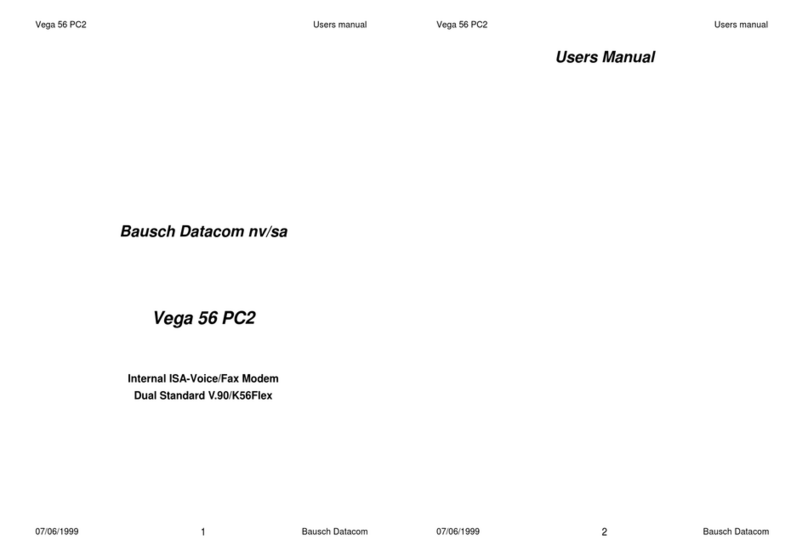
Bausch Datacom
Bausch Datacom Vega 56 PC2 User manual
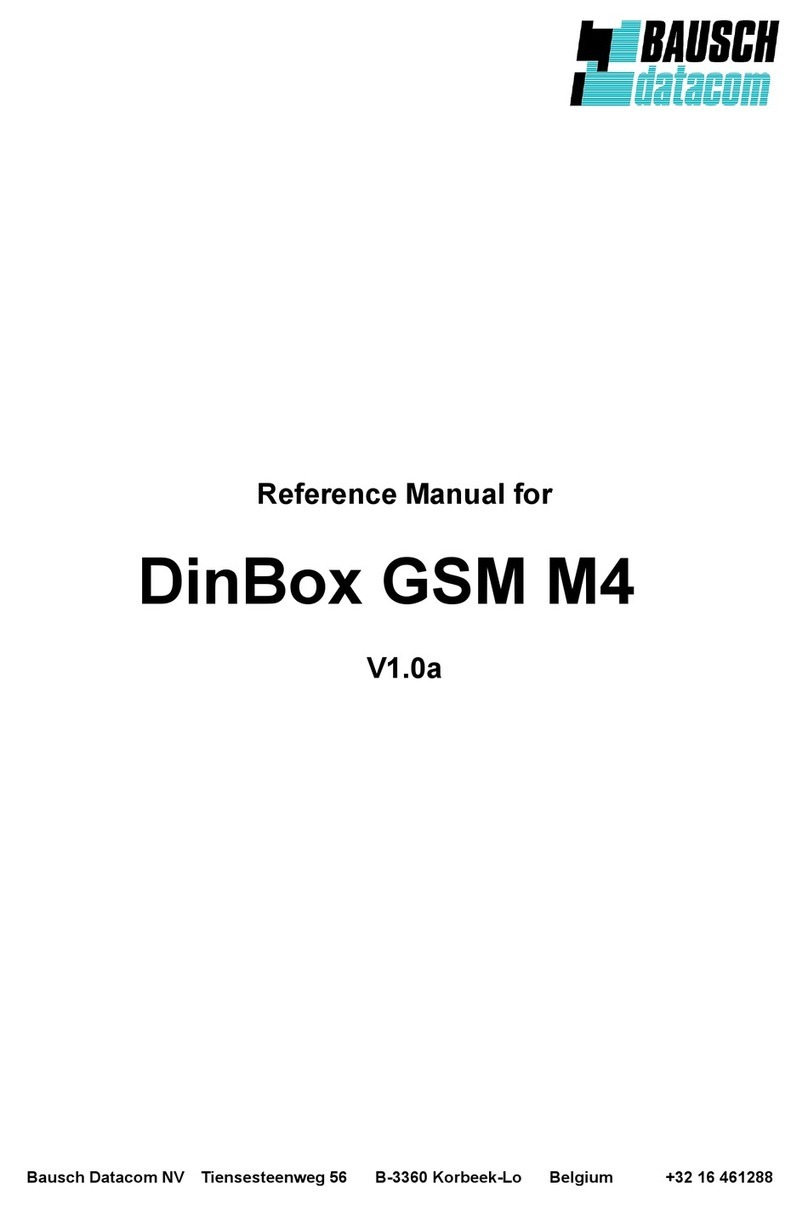
Bausch Datacom
Bausch Datacom DinBox GSM M4 User manual
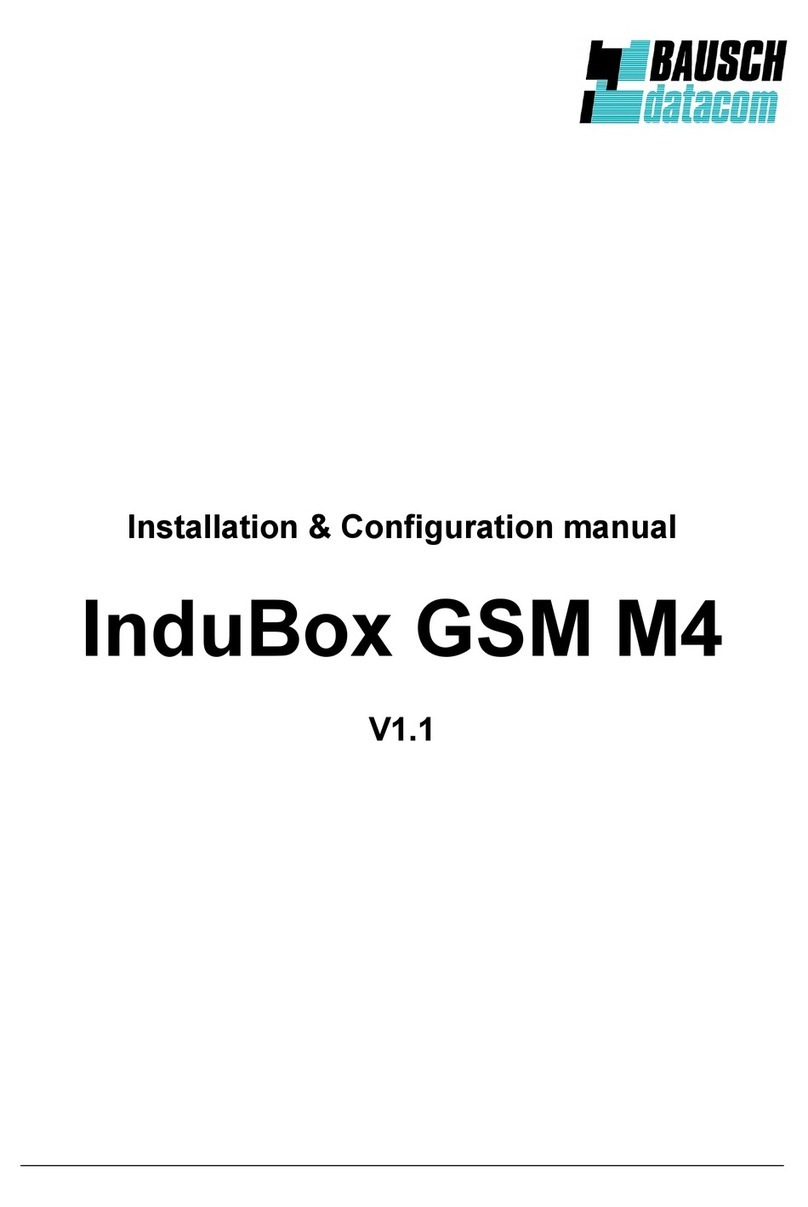
Bausch Datacom
Bausch Datacom InduBox GSM M4 Instruction sheet
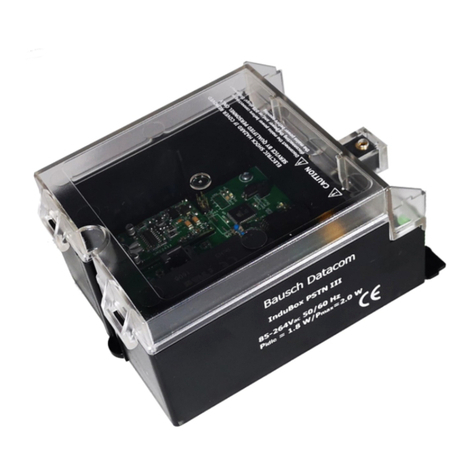
Bausch Datacom
Bausch Datacom InduBox PSTN III Instruction sheet
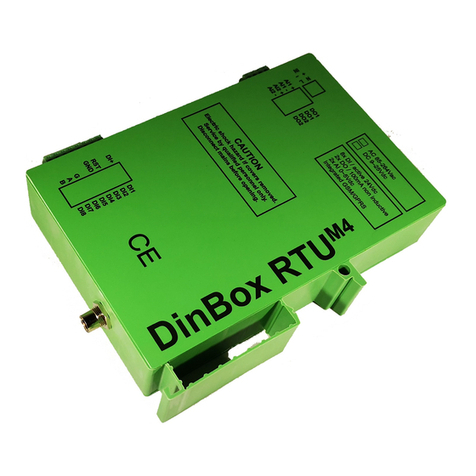
Bausch Datacom
Bausch Datacom DinBox RTU M4 User manual
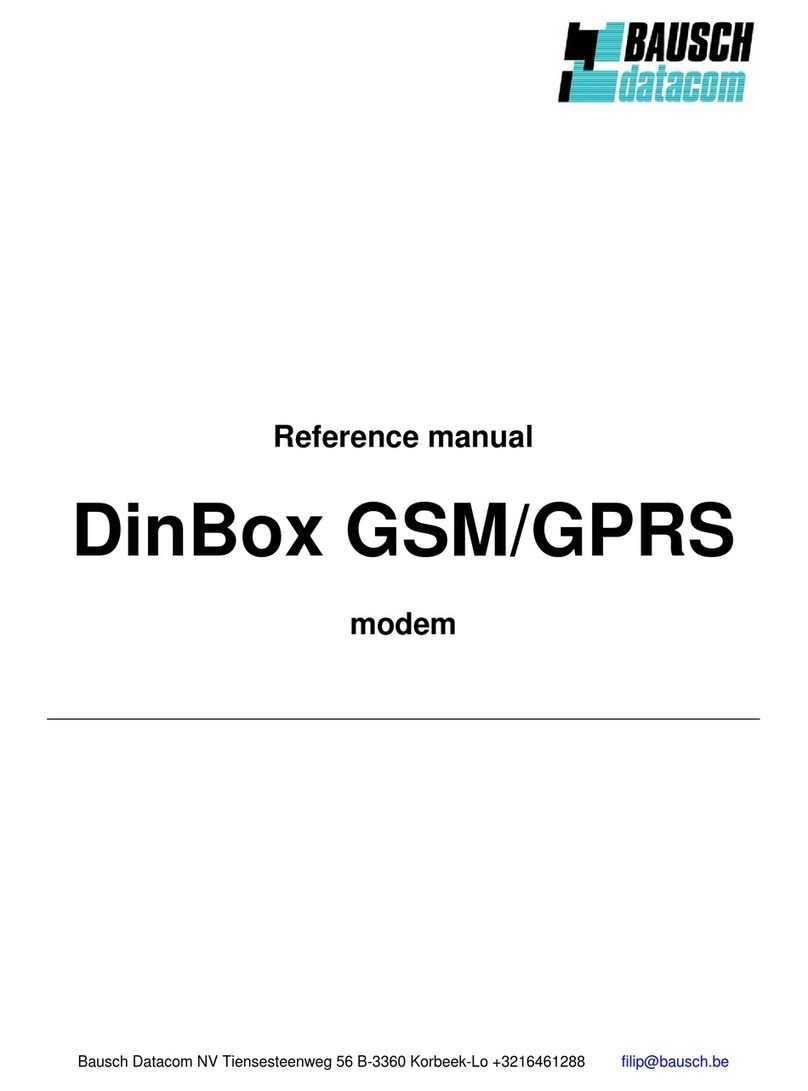
Bausch Datacom
Bausch Datacom DinBox User manual
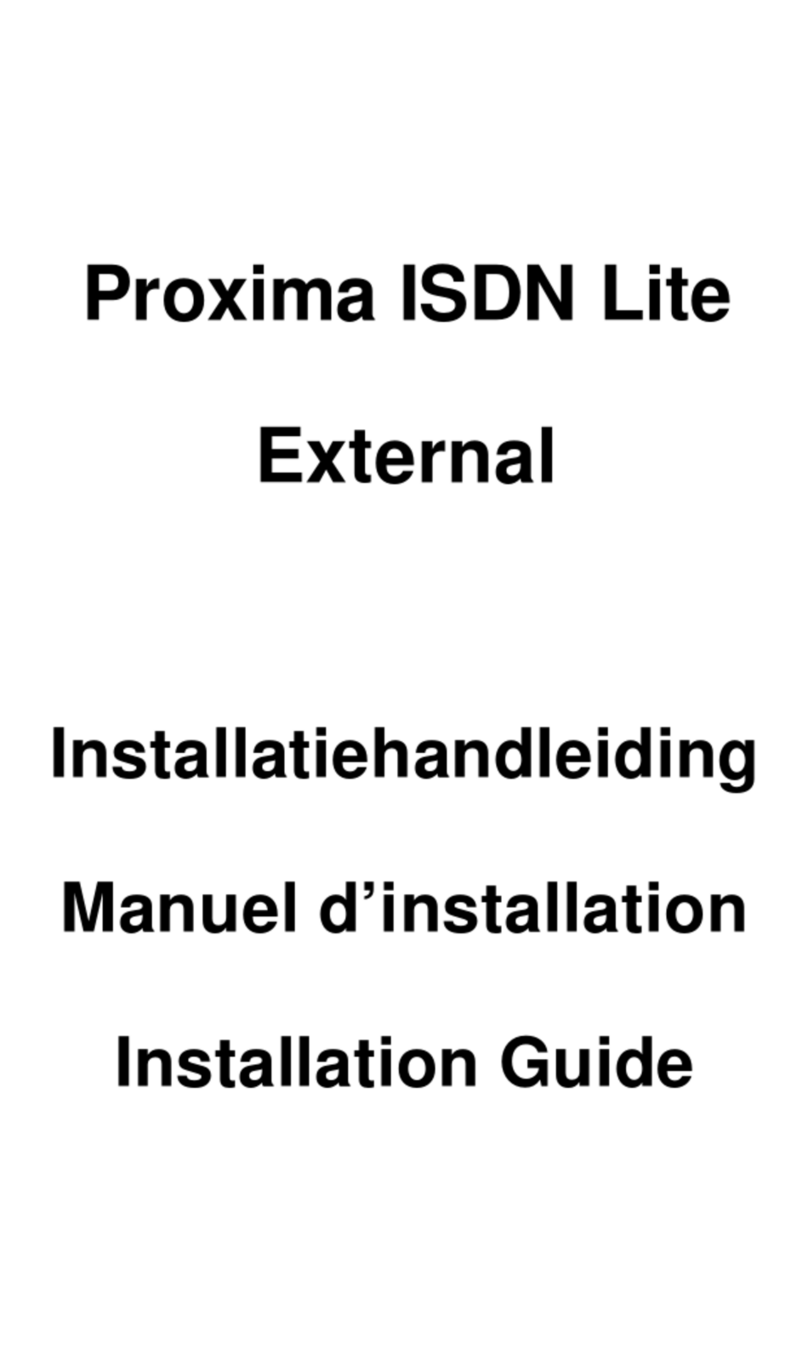
Bausch Datacom
Bausch Datacom Proxima ISDN Lite User manual
